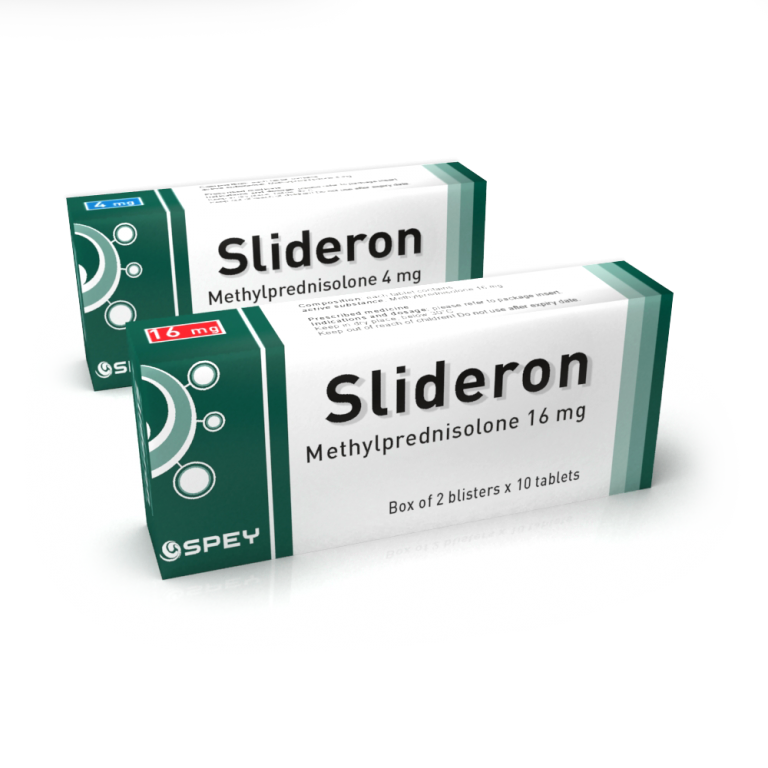
Slideron
Prescription
Download the instruction
Methylprednisolone in Slideron is a synthetic glucocorticoid with a pronounced action. Corticosteroids pass through cell membranes via diffusion to form complexes with specific cytoplasmic receptors which penetrate into the cell nucleus, bind the DNA and stimulate the transcription of the tRNA and subsequent protein synthesis of various enzymes with different functions in the body.
Composition
Methylprednisolone – 4 mg
Indications for use
The product is used as a substitution therapy in endocrine disorders, such as primary and secondary adrenal insufficiency, and congenital adrenal hyperplasia. It is used as a symptomatic agent in the following groups of diseases:
- In adjunction to the maintenance treatment and for short-term use for the management of an acute episode or exacerbation in rheumatic diseases: psoriatic arthritis, rheumatoid arthritis, including juvenile rheumatoid arthritis, ankylosing spondylitis, acute and subacute bursitis and tenosynovitis, acute podagrous arthritis, post-traumatic osteoarthritis, synovitis in osteoarthritis, epicondylitis
- During an exacerbation or for the maintenance treatment of systemic lupus erythematosus, systemic dermatomyositis, acute rheumatic carditis and giant cell arteritis
- Skin diseases – pemphigus, bullous herpetiform dermatitis, Steven-Johnson’s syndrome, exfoliative dermatitis, fungoid mycosis, severe psoriasis, severe seborrheic dermatitis
- Management of severe allergic conditions, refractory to conventional treatment -seasonal or non-seasonal allergic rhinitis, serum disease, bronchial asthma, drug hypersensitivity reactions, contact and atopic dermatitis
- Acute and chronic allergic and inflammatory processes with severe course, involving the eye and ocular appendages – allergic ulcers of the corneal margin, ophthalmic herpes zoster, inflammation of the anterior eye segment, diffuse posterior uveitis and choroiditis, sympathetic ophthalmia, allergic conjunctivitis, keratitis, chorioretinitis, iridocyclitis, optic neuritis;
- In pulmology and phtysiatrics, in sarcoidosis with pulmonary localisation, refractory Loeffler’s syndrome, berylliosis, fulminant or disseminated pulmonary tuberculosis, in the complex therapy with anti-tuberculous agents, aspiration pneumonitis
- Haematological diseases, such as idiopathic thrombocytopenic purpura in adults, secondary thrombocytopenia in adults, acquired (autoimmune) haemolytic anaemia, erythrocytic anaemia, congenital hypoplastic anaemia
- For palliative management in oncology – leukosis and lymphomas in adults and acute blastic leukosis in children
- Severe exacerbation in ulcerative colitis and Crohn’s disease
- Acute exacerbation of multiple sclerosis and brain tumour-associated oedema
- Tuberculous meningitis with subarachnoid block or impending block, in the complex therapy with anti-tuberculous agents
- Trichinellosis affecting the brain or myocardium
- Organ transplantation
- Nephrotic syndrome (without uremia, idiopathic or associated with lupus erythematosus) – for inducing diuresis or remission of proteinuria.
Mode of application
Adults: The amount of the initial dose may vary, depending on the type and severity of disease/condition and the response to the treatment performed. The treatment should continue at this dosage regimen to achieving the desired clinical response. Very high doses are required in multiple sclerosis (200 mg daily), brain oedema (200 – 1000 mg daily) and organ transplantation (up to 7 mg/kg daily). If no adequate clinical response has been achieved after a sufficient period of administration, re-evaluation is needed with regard to verifying the initial diagnosis or switching to another clinically adequate therapy.
Once the desired therapeutic response has been achieved, the daily dose should be gradually reduced, as soon as possible, to complete cessation of the treatment in acute conditions (seasonal asthma, exfoliative dermatitis, acute eye inflammation) or to achieving the minimal effective maintenance dose in chronic diseases/conditions (rheumatoid arthritis, systemic lupus erythematosus, bronchial asthma, atopic dermatitis).
In chronic diseases/conditions, it is important to take into consideration that the dose reduction (from the initial to the maintenance dose) should be done in a suitable way, depending on the clinical status, and to levels, where the risk of an eventual relapse of the disease is not high.
Children: The dosage in children is determined by the physician’s evaluation and is based on the clinical response. The treatment should be performed by administering the minimal effective dose for the shortest period of time. If possible, the daily dose should be administered as a single dose, every other day. Elderly: The treatment in the elderly, especially the continuous one, should be carefully performed with regard to more serious complications resultant from the undesirable effects in this age group, particularly, osteoporosis, diabetes, hypertension, higher susceptibility to infections and skin atrophy, etc.
Alternative dose regimen: In the alternative dose regimen, the daily dose is doubled and administered as a single daily dose, received at 08:00 in the morning, every other day.
With this type of therapy is meant, on one side, to ensure the positive therapeutic effects in patients with chronic diseases, and on the other, to diminish some of the severe undesirable effects, such as pituitary-adrenal suppression, Cushing’s syndrome, withdrawal symptoms and growth retardation in children.